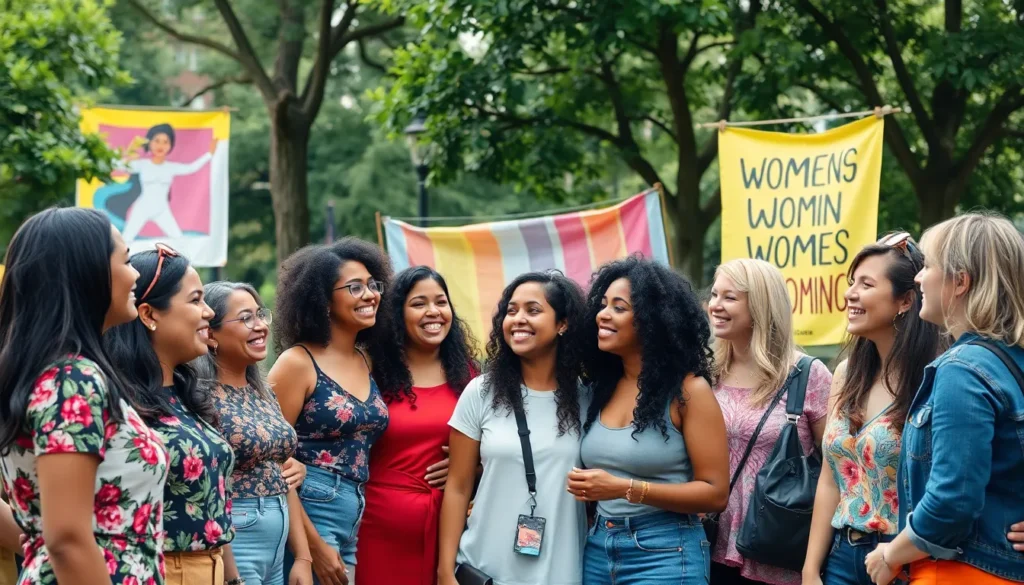Cultural feminism isn’t just another buzzword tossed around in academic circles; it’s a vibrant movement that celebrates the unique experiences and values women bring to society. Picture a world where the feminine perspective isn’t just acknowledged but cherished, where traits like empathy and cooperation take center stage instead of being sidelined. Sounds refreshing, right?
This approach dives deep into the roots of culture, exploring how art, literature, and social norms shape our understanding of gender. It challenges the status quo, urging society to embrace the strengths of femininity while critiquing the patriarchal structures that often stifle it. So grab your favorite cup of tea, settle in, and discover how cultural feminism is redefining the narrative and paving the way for a more inclusive future.
Table of Contents
ToggleOverview of Cultural Feminism
Cultural feminism emphasizes the importance of women’s experiences and the distinct qualities they bring to society. It presents feminine traits such as empathy, nurturing, and cooperation as vital components for social progress. Traditional patriarchal standards are challenged through this perspective, fostering a more inclusive environment.
Art acts as a significant medium in cultural feminism, reflecting and shaping women’s narratives. Literature highlights women’s voices, often neglected in mainstream discourse. By focusing on the everyday realities of women, cultural feminism pushes for recognition and understanding of their unique struggles and achievements.
Cultural norms play a crucial role in how gender is perceived. Efforts within cultural feminism aim to dismantle stereotypes and promote equitable representation of women. Rather than conforming to societal expectations, women are encouraged to embrace and celebrate their identities.
In various communities, cultural feminism thrives, creating spaces where women’s experiences are honored and validated. Movements focus on issues like body positivity and reproductive rights, advocating for women’s autonomy. Through education and activism, cultural feminists strive to reshape societal expectations and contribute to a future that values women’s perspectives.
Cultural feminism also intersects with other feminist ideologies, broadening the dialogue around gender equality. By collaborating across different movements, it creates a more comprehensive understanding of the challenges women face. This intersectionality fosters solidarity among diverse groups, enhancing the impact of feminist advocacy on a global scale.
Key Principles of Cultural Feminism

Cultural feminism centers around the distinct experiences of women, aiming to elevate their contributions in society. It promotes a new understanding of gender dynamics through unique feminine qualities.
Emphasis on Female Experience
Cultural feminism highlights the significance of women’s lived experiences. It acknowledges their challenges, joys, and perspectives as valid and essential. By prioritizing individual stories, this approach seeks to validate women’s voices in the broader societal context. Concrete examples of inherent strengths like nurturing and community-building provide a foundation for social change. This focus helps dismantle stereotypes and promotes a deeper understanding of women’s roles. Collective experiences lead to awareness and appreciation that enrich the feminist dialogue, fostering a society where women’s narratives gain prominence.
Critique of Patriarchy
Cultural feminism offers a robust critique of patriarchal systems. It questions longstanding norms that diminish female autonomy and contributions. By analyzing societal constructs, this movement advocates for a revaluation of values traditionally associated with femininity. Such a critique reveals how patriarchal structures perpetuate inequality. It pushes for recognition of traits like empathy and cooperation as strengths rather than weaknesses. By challenging these systems, cultural feminism promotes a more equitable environment where women can thrive. This transformative perspective encourages all genders to engage in fostering a balanced societal framework, amplifying feminist advocacy.
Historical Context
Cultural feminism emerged as a response to traditional feminism, focusing on the unique experiences and contributions of women. Its roots trace back to the late 20th century, influenced by various social movements advocating for women’s rights.
Origins of Cultural Feminism
Cultural feminism originated in the 1970s within the broader feminist movement. It built on earlier feminist thought by emphasizing feminine qualities as integral to social development. Influential figures, such as Carol Gilligan, challenged dominant patriarchal narratives, promoting a new understanding of gender dynamics. Her work highlighted the importance of relationship-focused values. This shift encouraged women to embrace their identities and assert their roles in society.
Evolution Over Time
Over the decades, cultural feminism evolved alongside changing societal attitudes towards gender and equality. By the 1980s and 1990s, it began intersecting with issues like racial and economic justice, broadening its scope. Scholars such as bell hooks articulated the need for an inclusive feminist dialogue. Activism focused on body positivity and reproductive rights gained momentum within the movement. Today, cultural feminism continues to advocate for diverse women’s voices and aims to dismantle stereotypes, reinforcing the significance of understanding women’s experiences in contemporary society.
Major Thinkers and Contributors
Cultural feminism features numerous thinkers and contributors who shape its core principles and ideas. Their work elevates women’s experiences and emphasizes the importance of feminine traits within society.
Key Figures in Cultural Feminism
Carol Gilligan stands out as a pivotal figure in cultural feminism. Her book “In a Different Voice” critiques traditional gender norms and emphasizes relational thinking. Judith Butler, through her work, questions gender norms and explores the performance of gender identity. bell hooks advocates for an inclusive and intersectional approach, challenging both patriarchy and racism. These thinkers provide a foundation for cultural feminism’s evolution, fostering dialogue around women’s roles and experiences.
Influential Works and Literature
Several key texts significantly contribute to the cultural feminist discourse. “In a Different Voice” by Carol Gilligan introduces crucial concepts about gender and relationships. “Gender Trouble” by Judith Butler reshapes understanding of gender identity and performance. bell hooks’ “Ain’t I a Woman?” critiques the intersections of race, gender, and class. These works reflect women’s narratives, challenge stereotypes, and inspire activism within cultural feminism, creating a richer understanding of women’s diverse experiences.
Cultural Feminism in Practice
Cultural feminism actively promotes women’s unique contributions and perspectives within various contexts. This practice offers real-world examples and addresses challenges, ensuring a nuanced understanding of the movement.
Case Studies and Examples
Art exhibits and literature reflect cultural feminism’s principles by showcasing women’s lived experiences. One notable case is the “The Feminist Art Movement” of the 1970s, which sought to challenge male dominance in the art world, promoting female artists and their narratives. The “Women’s March” provides another example, uniting diverse groups to voice concerns about women’s rights and social justice, emphasizing solidarity. Body positivity campaigns illustrate an ongoing commitment to redefining beauty standards, encouraging women to embrace their individuality. Educational initiatives like “Girls Who Code” exemplify efforts to empower girls in tech, promoting gender equity in fields historically dominated by men.
Challenges and Criticisms
Critics often argue cultural feminism can reinforce stereotypes, focusing too heavily on gender differences. This perception may lead to exclusionary practices that overlook the experiences of women from marginalized backgrounds. Some assert that the movement risks essentializing femininity, potentially undermining its broader goals for gender equality. Additionally, the intersection of cultural feminism with other feminist ideologies may lead to fragmentation, complicating collective action. Navigating these challenges requires ongoing dialogue and adaptation, ensuring that cultural feminism remains inclusive and responsive to diverse women’s voices.
Cultural feminism continues to play a vital role in reshaping societal perceptions of women and their contributions. By emphasizing the importance of women’s experiences and the value of traditionally feminine traits, it fosters a more inclusive dialogue around gender equality. This movement not only challenges patriarchal norms but also advocates for the representation and celebration of diverse women’s voices.
As cultural feminism evolves, it remains essential for ongoing discussions that address intersectionality and the complexities of women’s identities. Through education, activism, and artistic expression, cultural feminism inspires a future where women’s perspectives are recognized and valued, paving the way for a more equitable society.





